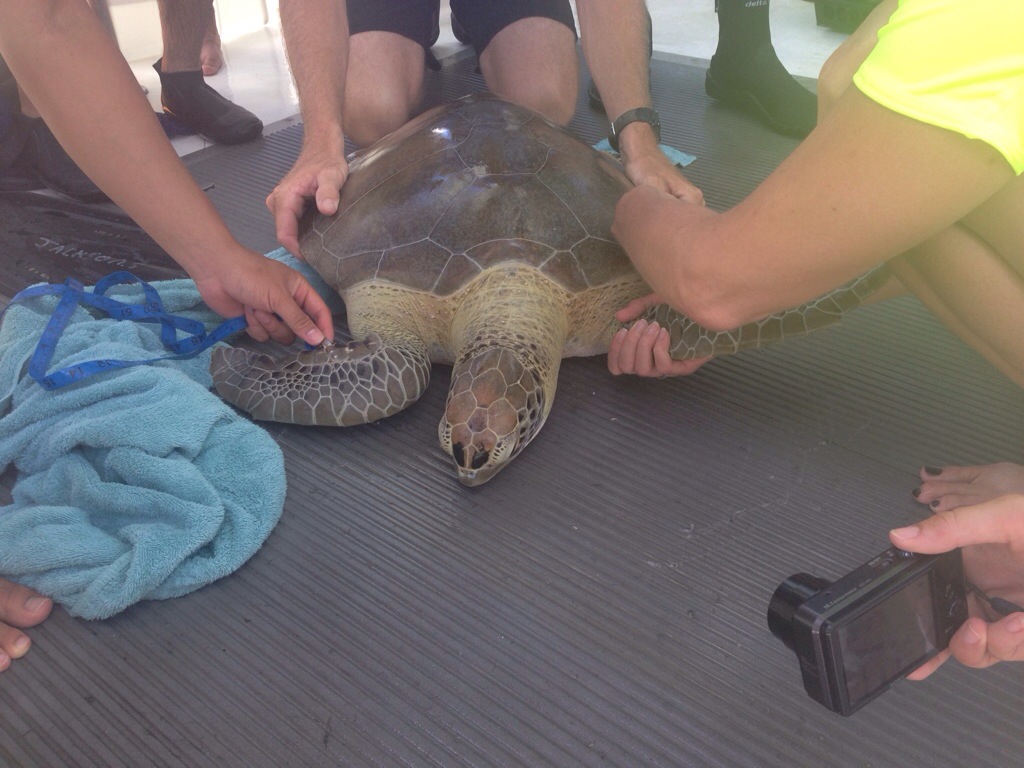Yesterday we started off the day by receiving a lesson on sea turtles and the different kinds that are around the world such as, the green sea turtle, hawksbill, and leatherback turtles. Dr. Gore explained to us the dangers for sea turtles, where they are found, their numbers, the technique used to catch them, and what happens when a tagged turtle is found. After the lesson we headed out to go catch some turtles to tag. We started off by being dragged through the water behind the boat six at a time, but because this didn’t work we moved to a new location, Savannah Bay, and just chased down the turtles. Mr. Golab was the one to help catch the turtle that happened to already be tagged. Once the turtle was on the boat we measured it and recorded the lengths of different parts of its body. After this we went to the baths which was formed by large rocks. These rocks were formed by magma that was encased by another substance. After everything cooled down and the secondary substance was washed away, these giant rocks were left behind. We continued to walk through these until we got to devil’s bay, where we started our snorkel back to the beach. After eating dinner on the beach, we began our night snorkel. We were all handed flash lights so we could see the different types of fish that would be out at night. While out there, we were able to see a multitude of things such as, squid, tarpon, plankton, and a lot of rays. Today our cabin woke up around 7:00 this morning to get ready for today’s busy and tiring dives. After we were ready to go, we headed out to breakfast and then to the boat. Once we were at the location, the wreck of the RMS Rhone near Salt Island, we were briefed for our first dive on what we would see once down at the bow of the ship. We were prepared to swim against and with a strong current that would be surrounding the bow of the ship that would make it more difficult to navigate around. We descended to around 80 feet to begin the dive around the wreck of the ship. Once there we swam around the wreck with the current, where we could see the side of the wreck and the fish that were surrounding it and living under neath it. We saw many different types of predatory fish around the wreck such as yellowtail snappers, and we also saw a lot of squirrel fish around the wreck. When we got to the back end of the wreck we started a swim through the bow, where it was dark and there were parts of the ship throughout the swim way. While in there we were able to see a small barracuda swimming back and forth through the small opening. Once my partner, Sean, and I were clear of the wreck we started our ascent to the surface where we learned about the history of the Rhone. We learned that it was deemed unsinkable but actually sunk shortly after the captain was washed overboard in a hurricane. We also learned that the ship was built in 1865 and shortly sunk after this in 1867. We then entered the water for the second dive which would be at the stern of the ship. At the beginning of the dive we were blue to see a very large fish known as the African pompano around other schooling snappers. We went through another part of the ship, where we came out by the massive 15 foot propeller made entirely of brass. We moved our way throughout the wreck seeing other things such as, the porthole that the one survivor came out of, known as lucky porthole number 26, and a silver spoon covered in coral. Once this dive was completed we went to cooper island for lunch and a snorkel. Before we started the snorkel, we had a short lesson on sea grass and the types of animals that we would find there. We were informed that we would be able to find rays, tarpons, and turtles in this area. We were able to see all of these things and more while snorkeling through the sea grass. We were also able to see angelfish, fairy basslets and lots of damsels in the grass. After the snorkel we headed back to Virgin Gorda where we went to mass and we were briefed by Casey on what we would be doing to transplant coral the next day. 




